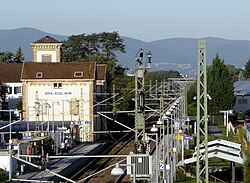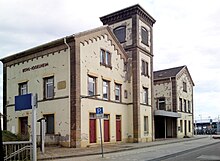Böhl-Iggelheim station
| Böhl-Iggelheim | |
|---|---|
 Böhl-Iggelheim station in September 2012
|
|
| Data | |
| Operating point type | Breakpoint |
| Location in the network | Intermediate station |
| Platform tracks | 2 |
| abbreviation | RBOE |
| IBNR | 8001057 |
| Price range | 5 |
| opening | June 11, 1847 |
| Architectural data | |
| Architectural style | Maximilian style |
| location | |
| City / municipality | Böhl-Iggelheim |
| Place / district | Bohl |
| country | Rhineland-Palatinate |
| Country | Germany |
| Coordinates | 49 ° 22 '48 " N , 8 ° 18' 19" E |
| Railway lines | |
|
|
| Railway stations in Rhineland-Palatinate | |
The Böhl-Iggelheim train station is the train station of the Rhineland-Palatinate municipality of Böhl-Iggelheim . It belongs to the Deutsche Bahn AG (DB) station category 5 and has two platform tracks . The station is in the network area of the Rhein-Neckar transport association (VRN) and belongs to tariff zone 121. Its address is Am Bahnhofsplatz 4 .
It is located on the Mannheim – Saarbrücken railway , which essentially emerged from the Palatinate Ludwigshafen – Bexbach railway . It was opened on June 11, 1847, when the Ludwigshafen –Neustadt section went into operation. Until after the Second World War, the station was important as a regional freight transshipment point, since around 1970 it has practically only been used for passenger traffic. In the meantime it has been dismantled to the halt. Since December 2003 it has also been part of the S1 and S2 lines of the RheinNeckar S-Bahn . Its former reception building is also a listed building .
location
The train station is located on the south-eastern edge of the Böhl district . The local Bahnhofstrasse runs parallel to the railway tracks in the north . To the south of the railway line is an industrial area and in this the street Am Bahnhofsplatz . The eastern area of the station is bridged by the state road 528 .
history
Railway initiatives around Böhl and Iggelheim
The original plan was to first open a north-south railway line within the Palatinate (Bavaria) from the Rheinschanze via Schifferstadt, Speyer and Lauterbourg to Strasbourg , which should compete with the Mannheim – Basel line planned by Baden . However, this was postponed in favor of an east-west main line, which was primarily intended to transport coal.
At first, however, it was unclear whether this east-west route should lead over the area of the then still independent municipalities of Böhl and Iggelheim. Speyer, the capital of the Palatinate, campaigned to become the eastern end of the route. The main argument was that the cathedral city was an old trading center, while the Rheinschanze , which was considered as an alternative to the end of the route, would serve as a mere military base for reloading goods. These efforts did not prevail, however, because the railway company mainly had the right bank of the Rhine-Neckar region - especially Mannheim - in view as a market and the export of coal to the area on the other side of the Rhine was considered more important.
East of Kaiserslautern , there were also two options for the route. Initially, the responsible engineers thought of a route over the Dürkheimer Tal and Bad Dürkheim , but finally decided on the variant through the Neustadter Tal. According to an expert opinion, overcoming this would also be difficult, but would not require stationary steam engines and cables. But even with this route it was originally planned to only build train stations in the neighboring towns of Schifferstadt and Haßloch. It was only subsequently agreed to provide Böhl with a station. In accordance with its importance for the neighboring village of Iggelheim, it was given the name "Böhl-Iggelheim".
Construction of the railway systems
In the Böhler district and in the neighboring communities, the implementation of the plans began in November 1844 with an information to the property owners concerned that their boundary stones should be made clearly visible. Seven owners in Böhl were initially unwilling to sell, but eventually gave in. Those owners who sold immediately received 14 guilders per unit, the hesitant ones received 6 guilders and 30 kreuzers. From June 1845, amounts below 100 guilders were paid out by the L. Dacque banking house in Neustadt. The actual construction work then began and was provisionally concluded with the opening of the Ludwig Railway on June 11, 1847. The railway operation also brought some jobs with it. In 1847 seven people from Böhl applied for services on the railway.
The local post office was also set up in the new station. In 1907 the community asked for the post office to be relocated to the center, but the Speyer Post Office insisted on staying in the station, among other things because the way from the center to the station was not far and because they wanted to keep the post and rail services together. The post office stayed in the station until 1920.
The railway facilities were expanded relatively quickly. A gatekeeper's house had already been built together with the station. In the autumn of 1847 a loading ramp for fattening and merchant cattle was built and in the following time there were other minor structural changes to the facilities. In 1868 there was still a gatekeeper's house on Mittelpfad, which was demolished in 1928.
Enlargement of the station in 1923
In 1922 the station was incorporated into the newly established Ludwigshafen Reich Railway Directorate . In the course of the dissolution of the Reich Railway Directorate in Ludwigshafen on April 1, 1937, he changed to the area of responsibility of the Mainz Directorate .
After the third track was built in 1923, the station was enlarged. An underpass, the signal box in the direction of Schifferstadt and a new large wooden ramp for loading goods were built. Coal in particular was loaded in Böhl, as there were a total of seven coal traders in Böhl and Iggelheim. Coal dealer Schmitt in Iggelheimer Strasse even had its own siding. The further cargo handling mainly comprised vegetables, livestock and all kinds of building materials. Local industry in particular benefited from the station. Large contingents of goods were pit wood from the Lenz company, bicycles from the Schwarz company and goods from the Schöffler paint factory. From 1933 the station had its own small locomotive for shunting the numerous freight wagons to be handled.
During the Second World War , the air raid on February 14, 1942 damaged the train station, the tracks, the power lines and some of the surrounding houses. The engine shed was completely destroyed.
Development since the Second World War
The German Federal Railways was divided the station after the Second World War in the Bundesbahndirektion Mainz one, they all railway lines within the newly created state of Rhineland-Palatinate allotted.
After the war, the station quickly regained importance as a goods transshipment point for local industry, with the Garthe and Orth companies in particular using the railway to transport their goods. However, the handling of goods soon declined again when the companies gave preference to goods transport by road. As a result of this development, the express goods shed on the station forecourt was demolished. The goods shed was temporarily rented to Garthe before it was also demolished in favor of a new high-speed track. The signal box was shut down around 1968.
In 1971 the station came under the responsibility of its Karlsruhe counterpart in the course of the dissolution of the Mainz management. In the period that followed, the station was reduced to a stopping point .
In 2003, as part of the integration of the Mannheim – Saarbrücken line to Kaiserslautern into the network of the RheinNeckar S-Bahn, the platforms were expanded to make them suitable for the disabled. The S-Bahn was opened on December 14, 2003, and the station has been integrated into its system ever since.
Buildings
The listed entrance building is a representative plastered building that was built in the so-called " Maximilian style ". Its middle part dates from 1847; the gabled house in the west and the stair tower were added in the 1860s. The eastern wing was built around 1910. It is no longer important for rail operations.
Web links
Individual evidence
- ↑ db-netz.de: Overview of the operating points and their abbreviations from Directive 100 . (PDF; 720 kB) Archived from the original on December 22, 2014 ; Retrieved April 6, 2014 .
- ↑ bahnseite.de: abbreviations of operating points on www.bahnseite.de . Retrieved April 6, 2014 .
- ↑ michaeldittrich.de: IBNR online search . Retrieved April 6, 2014 .
- ^ Vrn.de: Regional rail network and honeycomb plan . (PDF; 1.9 MB) (No longer available online.) Archived from the original on September 27, 2013 ; Retrieved April 6, 2014 .
- ^ Böhl-Iggelheim. In: bahnhof.de. Retrieved February 13, 2019 .
- ↑ a b denkmallisten.gdke-rlp.de: Informational directory of cultural monuments - Rhein-Pfalz-Kreis . (PDF) Retrieved April 6, 2014 .
- ↑ Heinz Sturm: The Palatinate Railways . 2005, p. 17th ff .
- ↑ Heinz Sturm: The Palatinate Railways . 2005, p. 58 f .
- ^ Fritz Engbarth: From the Ludwig Railway to the Integral Timetable. 160 years of railways in the Palatinate . 2007, p. 5 f .
- ↑ Heinz Sturm: The Palatinate Railways . 2005, p. 67 f .
- ↑ Heinz Sturm: The Palatinate Railways . 2005, p. 92 .
- ↑ Brendel 2005, p. 365.
- ↑ Ute Struppler: The postal system . In: Gemeindeverwaltung Böhl-Iggelheim (ed.): Böhl 780–2005. Böhl-Iggelheim 2005, pp. 362-364.
- ↑ Brendel 2005, p. 365/66.
- ↑ Fritz Engbarth: From the Ludwig Railway to the Integral Timed Timetable - 160 Years of the Railway in the Palatinate . 2007, p. 13 .
- ↑ Brendel 2005, pp. 367-369.
- ↑ Brendel 2005, p. 366.
- ↑ Brendel 2005, p. 369.
- ^ Heinz Sturm: History of the Maxbahn 1855-1945 . In: Model and Railway Club Landau in der Pfalz e. V. (Ed.): 125 years of Maximiliansbahn Neustadt / Weinstrasse-Landau / Pfalz . 1980, p. 66 .
- ↑ Brendel 2005, p. 369.
- ↑ Fritz Engbarth: From the Ludwig Railway to the Integral Timed Timetable - 160 Years of the Railway in the Palatinate . 2007, p. 28 .
literature
- Theo Brendel: The Railway. In: Gemeindeverwaltung Böhl-Iggelheim (ed.): Böhl 780–2005. Böhl-Iggelheim 2005, pp. 365-369.
- Heinz Sturm: The Palatinate Railways (= publications of the Palatinate Society for the Advancement of Science. Volume 53). New edition. pro MESSAGE, Ludwigshafen am Rhein 2005, ISBN 3-934845-26-6 .
